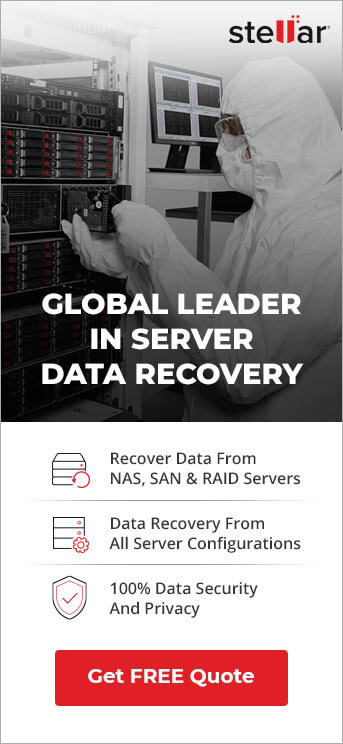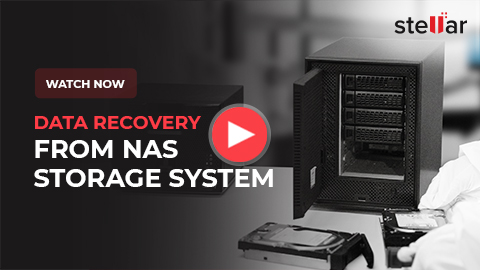Chapter 1 of 5 | Published On
Think of how you can easily upload all your media files to DropBox and then access them anywhere using the Internet. NAS lets you do just that, albeit the storage media remain on your premises, and are accessible only over your network. Of course, this is a layman’s definition of NAS. There’s a lot more to it.
In this chapter, we’ll offer answers to the following questions:
- What is NAS?
- Where is NAS used?
- What are RAID configurations for NAS?
What Is NAS?
NAS stands for network-attached storage.
NAS is a file-level storage device that enables file sharing across devices in a network (typically via a standard Ethernet connection).
Think of how you can easily upload all your media files to DropBox and then access them anywhere using the Internet. NAS lets you do just that, albeit the storage media remain on your premises, and are accessible only over your network.
So, NAS offers you speed and large storage, a certain extent of data protection by redundancy, along with the peace of mind of keeping your data in your own space instead of a public cloud.
This is what a NAS box looks like:
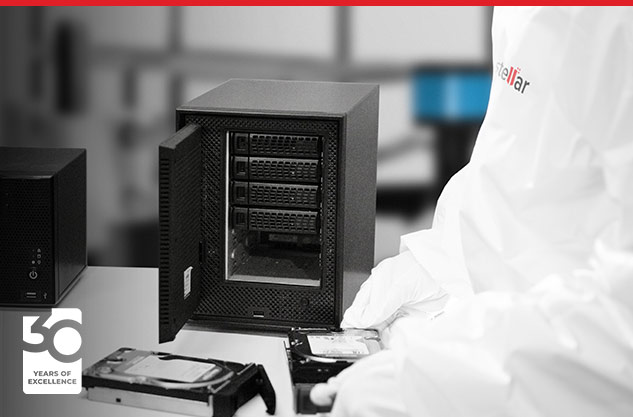
In a LAN (Local Area Network), each NAS exists as an independent network node with a unique IP address.
Think of NAS as a private cloud for your home or office. In comparison to a public cloud solution, NAS is cheaper and offers you more control.
What Is The Need For NAS?
As your business grows, so does the volume of data you produce every day. Even installing a network of IP (Internet Protocol) cameras will mean you need a storage solution to safeguard the video footage. So, typical storage solutions such as external hard drives will not work.
In fact, SMBs (small and midsize businesses) require storage solutions that can accommodate a lot of data, offer a certain level of redundancy for data protection, improve the read/write speed, and deliver data management capabilities. Plus, the system should be easy to scale up.
NAS offers a decent trade-off between all these quality parameters.
NAS: Key Components
The key components of a NAS solution are:
- The NAS device
- Built-in operating system
- Industry-standard network protocols like NFS (Network File System) and SMB (Server Message Block) for file service, and TCP/IP (Transmission Control Protocol/Internet Protocol) for data transfers
- Software for configuration
- The hard drives you fix inside your NAS box
Remember, your NAS is a storage device, not a storage media. Typically, what you pay is only for the housing of all the hard drives that will eventually make your NAS functional. So, the money you spend on NAS is not money spent on storage, until you buy all the hard drives that go inside the casing. Some vendors also offer NAS devices with built-in hard drives.
NAS: Manufacturers And Models
Some of the renowned NAS manufacturers are:
- Synology Inc.
- Western Digital Corp
- Buffalo
- QNAP
- Dell
- IBM
- Netgear
- Quantum Corp
The most common NAS models in the market are:
- WD My Cloud Personal NAS drive
- Seagate Personal Cloud 2-Bay NAS drive
- QNAP TS-251A NAS drive
- Buffalo LinkStation
- Synology DiskStation NAS drive
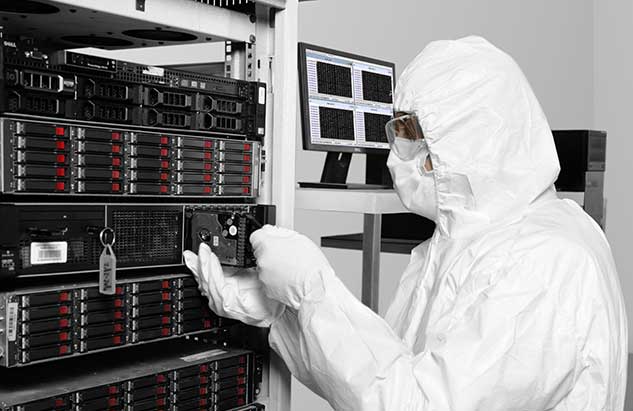
Where Is NAS Used?
NAS devices were primarily made for businesses but soon emerged as a useful storage solution for home use too. Let's understand how a NAS device may be used in these two contexts.
NAS use in SMEs
- Routine data backup maintenance
- Storing virtual machine (VM) images
- Serving frequently used multimedia files to a team of users
- Storing emails
- Hosting server-based applications like ERP (Enterprise Resource Planning), CRM (Customer Relationship Management), HRM (Human Resource Management)
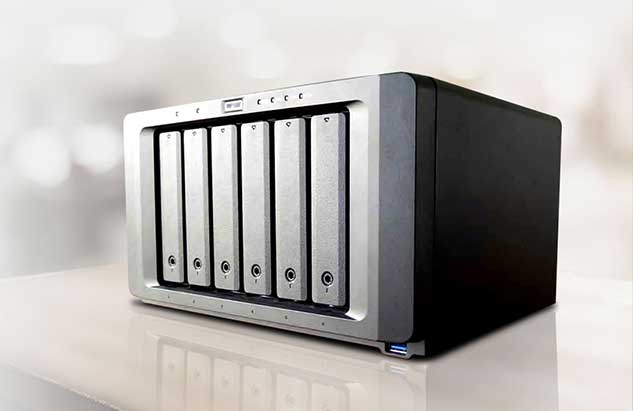
NAS use for consumer/household applications
- Storing recordings from smart TVs
- Serving frequently-used documents/multimedia files to a number of PCs/laptops
- Managing data from IoT (Internet of Things) devices
- Hosting a personal cloud
- Storing video footage from home security cameras
What Are The Common RAID Configurations For NAS?
What Is RAID?
RAID is an acronym for Redundant Array of Independent/Inexpensive Disks (RAID). A RAID is configured to secure data in a storage setup that uses multiple storage media. RAID can create redundancy and also improve performance.
In a RAID setup, some of the storage drives in an array are used to store a backup of the data in the other drives. Note that RAID isn’t an alternative to offsite backing up of data. Before we go further, let’s understand the meaning of 3 common terms.
- Striping: Splitting data between different disks
- Mirroring: Duplicating data from one disk to another.
- Parity: A calculated value (also called a checksum) that may be used to redevelop lost data, or verify the correctness of data
Know about the possibility of Raid recovery from all raid configuration.
Different RAID Configurations For NAS
- RAID 0
- RAID 1
- RAID 4
- RAID 5
- RAID 6
- RAID 10
In a RAID 0 setup, all the available drives are striped (or combined) together.
In a way, all your hard drives work as one giant hard drive from a storage point of view. For example, in a 4-bay NAS with 4 HDDs of 1 TB each, your RAID 0 configuration gives you 4 TB of available storage. Your data is distributed across
these HDDs, which means fast read/write speeds. The downside is that if/when one of those hard drives fails, you might lose your data because the data won't have been backed up on any of the other drives.
In a RAID 1 setup, half the number of drives in the NAS are set up to mirror the data in the other half. This ensures backup against data loss in any of the hard drives.
In a RAID 4 setup, one of the drives is used to store parity information, while the others are available for storage as usual. Read More
In a RAID 5 setup, the parity information is spread across all the drives in the NAS. So, if one hard drive fails, you can still rebuild the data because its parity information is stored across all the drives. In this way,
RAID 5 is an improvement over RAID 4.
The downside is that RAID 5 only supports the failure of one hard drive. If more than one drive were to fail, the system of parity information storage
will not let you rebuild the missing data.
In a RAID 6 configuration, this problem is solved by storing the parity information in two blocks in all the drives (instead of one block in all the drives).
In a RAID 10 configuration, disk striping and mirroring are combined.
You need a minimum of 4 disks for RAID 10. Your hard drives function as two mirrored pairs (in the case of a 4 HDD RAID 10 setup). Data is striped across the mirrored pairs.
This table summarizes the key points for each RAID configuration.
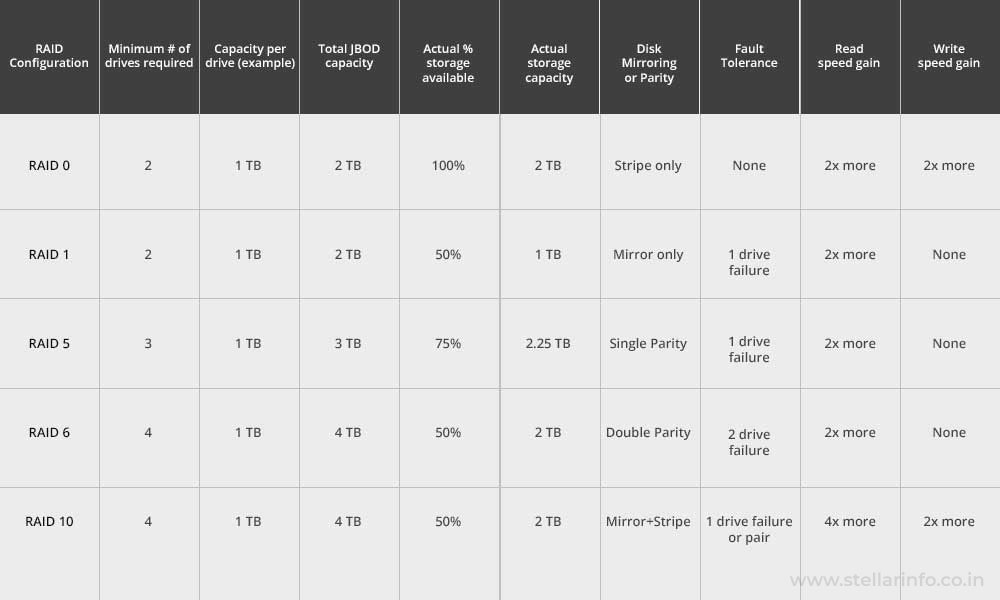
Summary
In this chapter, we learned:
- NAS is a bunch of hard disks attached together in an enclosure, which makes the stored data available over a local network, for multiple devices.
- NAS lets SMBs enjoy a higher performance, reliable data backup, and better speed.
- RAID configurations allow users to decide which trade-off of speed, performance, and data security suits them the best. RAID 5 is most commonly used.
